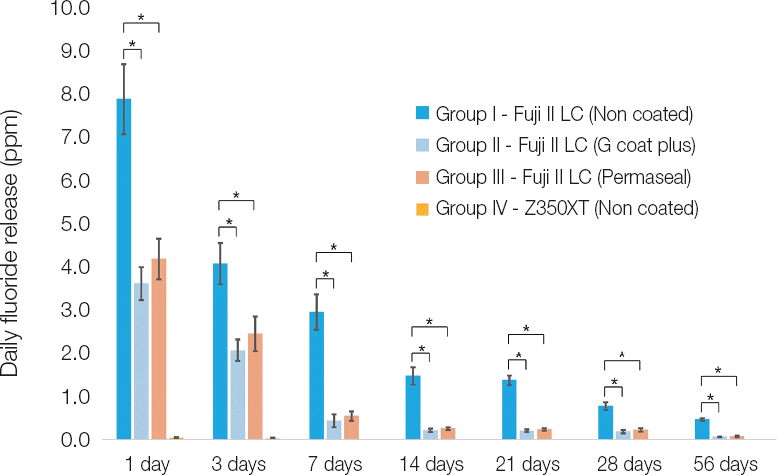1. Moses J, Rangeeth BN, Gurunathan D. Prevalence of dental caries, socio-economic status and treatment needs among 5 to 15 year old school going children of Chidambaram. JCDR. 2011; 5:146–51.
2. Kramer N, Schmidt M, Lucker S, Domann E, Frankenberger R. Glass ionomer cement inhibits secondary caries in an in vitro biofilm model. Clin Oral Ivestig. 2018; 22:1019–31. DOI:
10.1007/s00784-017-2184-1. PMID:
28741172.
3. Croll TP, Nicholson JW. Glass ionomer cement in pediatric dentistry:review of the literature. Pediatr Dent. 2002; 24:423–9. PMID:
12412956.
4. Khoroushi M, Keshani F. A review of glass-ionomers:From conventional glass-ionomer to bioactive glass-ionomer. Dent Res J. 2013; 10:411–20. PMID:
24130573. PMCID:
PMC3793401.
5. Haznedaroğlu E, Guner Ş, Duman C, Menteş A. A 48-month randomized controlled trial of caries prevention effect of a one-time application of glass ionomer sealant versus resin sealant. Dent Mater J. 2016; 35:532–8. PMID:
27086573. DOI:
10.4012/dmj.2016-084.
6. Itota T, Nakabo S, Iwai Y, Konishi N, Nagamine M, Torii Y. Inhibition of artificial secondary caries by fluoride-releasing adhesives on root dentin. J Oral Rehabil. 2002; 29:523–7. DOI:
10.1046/j.1365-2842.2002.00858.x. PMID:
12071919.
8. Karaoğlanoğlu S, Akgul N, Ozdabak HN, Akgul HM. Effectiveness of surface protection for glass-ionomer, resin modified glass ionomer and polyacid-modified composite resins. Dent Mater J. 2009; 28:96–101. DOI:
10.4012/dmj.28.96. PMID:
19280974.
9. Kamatham R, Reddy SJ. Surface coatings on glass ionomer restorations in Pediatric dentistry - Worthy or not? J Indian Soc Pedod Prev Dent. 2013; 31:229–33. DOI:
10.4103/0970-4388.121818. PMID:
24262395.
10. Soderholm KJ. Coatings in dentistry - a review of some basic principles. Coatings. 2012; 2:138–59. DOI:
10.3390/coatings2030138.
11. Hattab FN, Amin WM. Fluoride release from glass ionomer restorative materials and the effects of surface coating. Biomaterials. 2001; 22:1449–58. DOI:
10.1016/S0142-9612(00)00253-2. PMID:
11374443.
12. Tiwari S, Nandlal B. Effect of nano-filled surface coating agent on fluoride release from conventional glass ionomer cement:an in vitro trial. J Indian Soc Pedod Prev Dent. 2013; 31:91–5. DOI:
10.4103/0970-4388.115703. PMID:
23886719.
13. Lee MJ, Kim KM. A study on the fluoride release, microhardness and cytotoxicity of fluoride releasing restorative materials. Korean J Dent Mater. 2016; 43:299–306. DOI:
10.14815/kjdm.2016.43.4.299.
14. Lee KY, Lee SH, Lee NY, Jih MK. A Comparison of the Amount of Fluoride Ion Released and Remineralization Effect on the Initial Caries Lesion of the Various Fluoride Varnishes. J Korean Acad Pediatr Dent. 2016; 43:443–51. DOI:
10.5933/JKAPD.2016.43.4.443.
16. Piwowarczyk A, Lauer HC. Mechanical properties of luting cements after water storage. Oper Dent. 2003; 28:535–42. PMID:
14531599.
17. Hosaka K, Nakajima M, Takahashi M, Itoh S, Ikeda M, Tagami J, Pashley DH. Relationship between mechanical properties of one-step self-etch adhesives and water sorption. Dent Mater. 2009; 26:360–7. DOI:
10.1016/j.dental.2009.12.007.
18. Chuang SF, Jin YT, Tsai PF, Wong TY. Effect of various surface protections on the margin microleakage of resin-modified glass ionomer cements. J Prosthet Dent. 2001; 86:309–14. DOI:
10.1067/mpr.2001.116133. PMID:
11552169.
20. Yli-Urpo H, Vallittu PK, Narhi TO, Forsback AP, Vakiparta M. Release of silica, calcium, phosphorus, and fluoride from glass ionomer cement containing bioactive glass. J Biomater Appl. 2004; 19:5–20. DOI:
10.1177/0085328204044538. PMID:
15245640.
21. Hayacibara MF, Ambrozano GM, Cury JA. Simultaneous release of fluoride and aluminum from dental materials in various immersion media. Oper Dent. 2004; 29:16–22. PMID:
14753327.
22. Gurgan S, Kutuk ZB, Ergin E, Oztas SS, Cakir FY. Four-year randomized clinical trial to evaluate the clinical performance of a glass ionomer restorative system. Oper Dent. 2015; 40:134–43. DOI:
10.2341/13-239-C. PMID:
25299703.
23. Mousavinasab SM, Khosravi K, Tayebghasemi N. Microleakage Assessment of Class V Composite Restorations Rebonded with Three Different Methods. Dent Res J. 2008; 5:21–6.
24. Shiozawa M, Takahashi H, Iwasaki N. Fluoride release and mechanical properties after 1-year water storage of recent restorative glass ionomer cements. Clin Oral Investig. 2014; 18:1053–60. DOI:
10.1007/s00784-013-1074-4. PMID:
23974799.
25. Karantakis P, Helvatjoglou-Antoniades M, Theodoridou-Pahini S, Papadogiannis Y. Fluoride release from three glass ionomers, a compomer, and a composite resin in water, artificial saliva, and lactic acid. Oper Dent. 2000; 25:20–5. PMID:
11203786.
26. Yip HK, Smales RJ. Fluoride release from a polyacid-modified resin composite and 3 resin-modified glass-ionomer materials. Quintessence Int. 2000; 31:261–6. PMID:
11203934.
27. Mazzaoui SA, Burrow MF, Tyas MJ. Fluoride release from glass ionomer cements and resin composites coated with a dentin adhesive. Dent Mater. 2000; 16:166–71. DOI:
10.1016/S0109-5641(00)00003-8. PMID:
10762676.
28. Wiegand A, Buchalla W, Attin T. Review on fluoride-releasing restorative materials-fluoride release and uptake characteristics, antibacterial activity and influence on caries formation. Dent Mater. 2007; 23:343–62. DOI:
10.1016/j.dental.2006.01.022. PMID:
16616773.
29. Gao W, Smales RJ. Fluoride release/uptake of conventional and resin-modified glass ionomers, and compomers. J Dent. 2001; 29:301–6. DOI:
10.1016/S0300-5712(00)00053-1. PMID:
11525231.
30. Aliping-McKenzie M, Linden RW, Nicholson JW. The effect of saliva on surface hardness and water sorption of glass-ionomers and “compomers”. J Mater Sci Mater Med. 2003; 14:869–73. DOI:
10.1023/A:1025630609544. PMID:
15348524.



